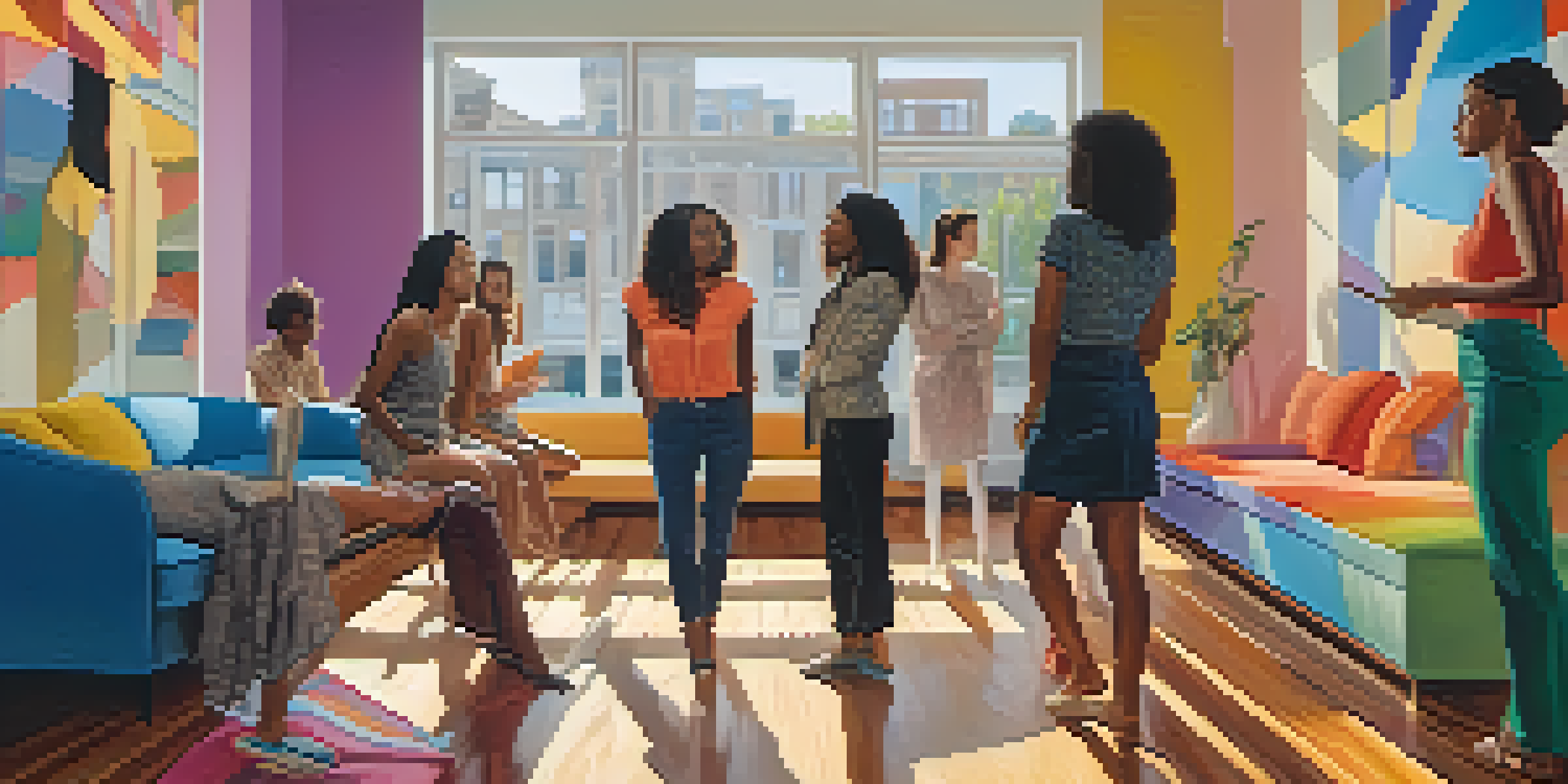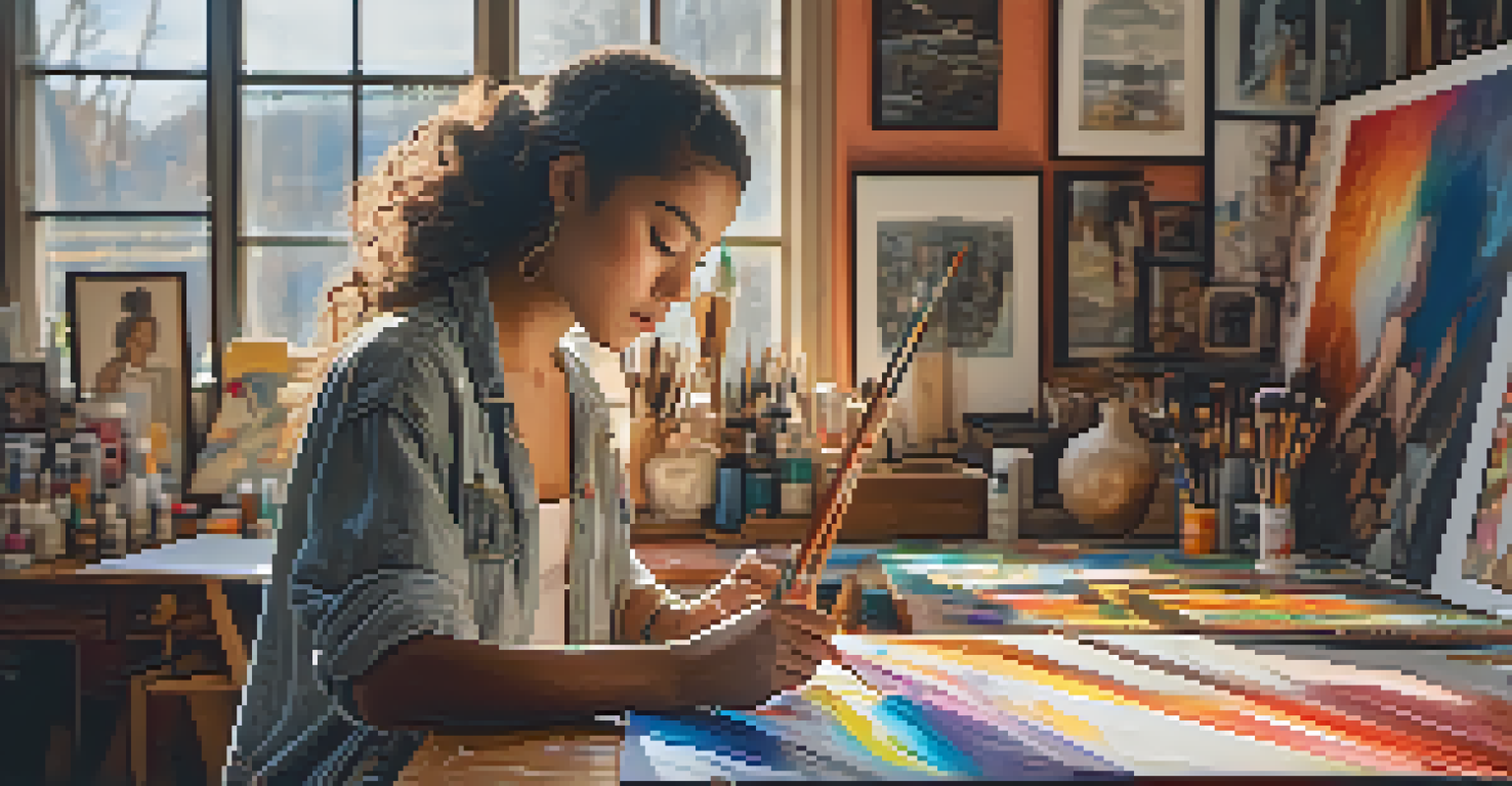New Perspectives: Feminism and Identity in Modern Paintings

Understanding Feminism in Contemporary Art
Feminism in contemporary art serves as a lens through which we can examine women's experiences and challenges in society. Artists use their work to highlight issues like gender inequality, representation, and empowerment. By weaving feminist themes into their paintings, they invite us to question traditional narratives and embrace a more inclusive perspective.
Art is not a mirror held up to reality, but a hammer with which to shape it.
For instance, artists like Judy Chicago and Frida Kahlo have shaped the feminist art movement by showcasing personal narratives that resonate with broader societal issues. Their works provoke thought and discussion, pushing boundaries and encouraging viewers to engage with the subject matter on a deeper level. This engagement is crucial in fostering a greater understanding of feminism's role in art.
Ultimately, contemporary art acts as a powerful platform for feminist expression, giving voice to those who have been historically marginalized. As we explore these pieces, we uncover not just the artists' intentions, but also the cultural contexts that shape their work and resonate with audiences today.
Identity as a Central Theme in Modern Paintings
Identity plays a pivotal role in modern paintings, allowing artists to explore and express their unique backgrounds and experiences. This exploration often intersects with themes of race, gender, sexuality, and culture, creating a rich tapestry of narratives. By addressing identity, artists challenge viewers to reflect on their own perceptions and biases.

Take, for example, the work of Kehinde Wiley, who reimagines traditional portraiture by featuring people of color in grand, historical poses. This not only reclaims space for underrepresented identities but also invites a dialogue about race and representation in art. Through such innovative approaches, artists can transform our understanding of identity and its implications.
Feminism Shapes Contemporary Art
Artists use feminist themes to highlight women's experiences and challenge societal norms in their work.
As we delve into these modern paintings, we find that identity is not a single story but rather a collection of experiences that shape who we are. This realization encourages us to appreciate the complexity of individual identities and the myriad ways they can be represented in art.
Intersectionality: The Blend of Feminism and Identity
Intersectionality is a crucial concept in understanding the relationship between feminism and identity in modern art. It recognizes that individuals hold multiple identities that can influence their experiences differently. This idea pushes artists to reflect on how various aspects of identity—such as race, class, and gender—interact and affect one another.
Feminism is for everybody.
Artists like Amani Lewis and Zanele Muholi exemplify this intersectional approach in their work. They highlight how overlapping identities can lead to unique experiences of oppression and resilience. By showcasing these complexities, their art challenges us to see beyond singular narratives and embrace a more nuanced understanding of identity.
In the realm of modern paintings, intersectionality opens doors for diverse voices and stories that may have previously been overlooked. This rich dialogue not only enhances the depth of art but also fosters empathy and understanding among viewers from different backgrounds.
The Role of Personal Narrative in Modern Art
Personal narrative serves as a powerful tool for artists to convey their experiences and perspectives. In modern paintings, these narratives often reflect broader societal issues, transforming individual stories into collective dialogues. This connection allows viewers to engage with the art on a personal level, fostering empathy and understanding.
Consider the works of artists like Tracey Emin, whose autobiographical pieces reveal intimate aspects of her life, inviting audiences into her world. Through her raw and honest storytelling, she creates a space for others to reflect on their own experiences. This authenticity in art can resonate deeply, encouraging viewers to confront their feelings and understand diverse perspectives.
Identity Enriches Artistic Narratives
Modern paintings explore the complexity of identity, allowing artists to express diverse backgrounds and experiences.
By incorporating personal narratives into their work, artists not only validate their experiences but also challenge societal norms. This act of storytelling empowers both the artist and the audience, fostering a sense of community and shared understanding in the face of complex identity issues.
Challenging Gender Norms Through Artistic Expression
Modern paintings often challenge traditional gender norms, pushing boundaries and redefining roles through artistic expression. Artists use their work to confront stereotypes, question societal expectations, and envision new possibilities for gender identity. This exploration encourages viewers to rethink their own beliefs and assumptions.
For example, the work of artists like Cindy Sherman and Nan Goldin reflects the fluidity of gender and the complexities of identity. By presenting unconventional representations of gender, they encourage audiences to engage in conversations about what it means to be male or female in contemporary society. This dialogue is vital in breaking down rigid binary notions of gender.
In this way, art becomes a catalyst for change, inspiring individuals to embrace diverse gender expressions and challenge societal norms. As we reflect on these modern paintings, we recognize the power of art to provoke thought and encourage a more inclusive understanding of gender.
Cultural Context: The Influence on Artistic Identity
Cultural context plays a significant role in shaping an artist's identity and their work. Modern paintings often reflect the cultural backgrounds and experiences of the artists, providing insight into how these factors influence their artistic expression. By understanding the cultural context, we can better appreciate the nuances and intentions behind the artwork.
For instance, artists like Alma Thomas and Njideka Akunyili Crosby draw upon their African heritage to inform their paintings. Their cultural experiences enrich their work and offer viewers a unique perspective on identity and belonging. This connection to culture can deepen the emotional resonance of the art, making it all the more impactful.
Intersectionality Enhances Understanding
The intersection of feminism and identity in art reveals unique experiences and fosters empathy among viewers.
As we explore modern paintings, it's essential to recognize the diverse cultural influences that shape artistic identity. This awareness enhances our understanding of the artwork, allowing us to engage with it on a more profound level and appreciate the richness of the stories being told.
The Future of Feminism and Identity in Art
The future of feminism and identity in art looks vibrant and promising, as new voices continue to emerge and challenge the status quo. As society evolves, so too does the conversation around identity and representation in art. This dynamic landscape offers endless opportunities for artists to explore and express their unique perspectives.
With the rise of digital media and technology, artists are finding innovative ways to share their stories and reach wider audiences. This accessibility allows for more diverse voices to be heard, enriching the art world with varied experiences and viewpoints. As a result, we can expect to see an even broader range of feminist and identity-driven themes in modern paintings.

Ultimately, the intersection of feminism and identity in art will continue to evolve, reflecting the complexities of our society. By embracing these changes, we can foster a more inclusive art community that celebrates diversity and encourages ongoing dialogue about the issues that matter most.